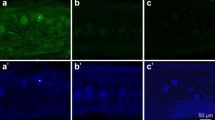Summary
The tail of the gymnotid Sternarchus albifrons, including the spinal cord, regenerates following amputation. Regenerated spinal cord shows a rostro-caudal gradient of differentiation. Cross sections of the most distal regenerated cord show radially enlarged ependymal cells, relatively undifferentiated cells, and numerous blood vessels. More anterior sections contain well differentiated electromotor neurons, glial cells, and myelinated axons. The number of electromotor-neuron cell bodies in cross sections of regenerated spinal cord is three to six times the number in nonregenerated cord. Distinct tracts of axons, easily identifiable in normal cord, are not distinguishable in cross sections of regenerated cord. Some reorganization of the spinal cord also appears to take place anterior to the site of transection.
Individual electromotor neurons in the regenerated spinal cord have morphologies largely similar to those of normal electrocytes, i.e., cell bodies are rounded, lack dendrites, have synapses characterized by gap junctions with presynaptic axons, and lack an unmyelinated initial segment. The presence of electromotor neurons with normal morphology in regenerated spinal cord correlates with the re-establishment of relatively normal electrocyte axonSchwann cell relationships in the regenerating electric organ of this sternarchid.
Similar content being viewed by others
References
Bennett MVL (1971) Electric Organs. In: Hoar WS, Randall DJ (eds) Fish Physiology. Academic Press Inc. New York, pp 347–491
Bennett MVL, Sandri C, Akert K (1978) Neuronal gapjunctions and morphologically mixed synapses in the spinal cord of a teleost, Sternarchus albifrons (Gymnotoidei). Brain Res 143:43–60
Bennett MVL, Pappas GD, Giménez M, Nakajima Y (1967) Physiology and ultrastructure of electrotonic junctions. IV Medullary electromotor nuclei in gymnotid fish. J Neurophysiol 30:236–300
Egar M, Singer M (1972) The role of ependyma in spinal cord regeneration in the Urodele, Triturus. Exp Neurol 37:422–430
Egar M, Simpson SB, Singer M (1970) The growth and differentiation of the regenerating spinal cord of the lizard Anolis carolinensis. J Morphol 131:131–152
Hughes A (1961) Cell degeneration in the larval ventral horn of Xenopus laevis (Daudin). J Embryol Exp Morphol 9:269–284
Koppanyi T (1955) Regeneration in the central nervous system of fish. In: Windle WF (ed) Regeneration in the central nervous system. Thomas Springfield, Illinois, pp 3–19
Needham AE (1952) Regeneration and wound-healing. Methuen and Co. Ltd, London
Nordlander RH, Singer M (1978) The role of ependyma in regeneration of the spinal cord in the urodele amphibian tail. J Comp Neurol 180:349–374
Oliveira Castro G de (1955) Differentiated nervous fibers that constitute the electric organ of Sternarchus albifrons Linn. Ann Acad Brasil Cien 4:557–562
Pappas GD, Waxman SG, Bennett MVL (1975) Morphology of spinal electromotor neurons and presynaptic coupling in the gymnotid Sternarchus albifrons. J Neurocytol 4:469–478
Prestige MC (1970) Differentiation, degeneration, and the role of the periphery: quantitative considerations. In: Schmitt FO (ed) The Neurosciences: Second Study Program. Rockefeller Univ Press, New York, pp 73–82
Purpura DP (1967) Comparative physiology of dendrites. In: Quarton GC, Melnechuk T, Schmitt FO (eds) The Neurosciences. Rockefeller Univ Press, New York, pp 372–393
Simpson SB (1964) Analysis of tail regeneration in the lizard Lygosoma laterale. I. Initation of regeneration and cartilage differentiation: the role of ependyma. J Morphol 114:425–436
Singer M, Nordlander RH, Egar M (1979) Axonal guidance during embryogenesis and regeneration in the spinal cord of the newt: the blueprint hypothesis of neuronal pathway patterning. J Comp Neurol 185:1–22
Tokunaga A, Akert K, Sandri C, Bennett MVL (1980) Cell types and synaptic organization of the medullary electromotor nucleus in a constant frequency weakly electric fish. Sternarchus albifrons. J Comp Neurol 192:407–426
Waxman SG, Quick DC (1978) Functional architecture of the initial segment. In: Waxman SG (ed) Physiology and Pathobiology of Axons. Raven Press, New York, pp 125–131
Waxman SG, Anderson MJ (1980) Regeneration of spinal electrocyte fibers in Sternarchus albifrons: Development of axon-Schwann cell relationships and nodes of Ranvier. Cell Tissue Res 208:343–352
Waxman SG, Pappas GD, Bennett MVL (1972) Morphological correlates of functional differentiation of nodes of Ranvier along single fibers in the neurogenic electric organ of the knife fish Sternarchus. J Cell Biol 53:210–224
Author information
Authors and Affiliations
Additional information
Supported in part by the Medical Research Service, Veterans Administration and by a grant from the National Institutes of Health. We also thank the Paralyzed Veterans of America for their support. We thank Mary E. Smith and Susan Cameron for excellent technical support
Rights and permissions
About this article
Cite this article
Anderson, M.J., Waxman, S.G. Morphology of regenerated spinal cord in Sternarchus albifrons . Cell Tissue Res. 219, 1–8 (1981). https://doi.org/10.1007/BF00210014
Accepted:
Issue Date:
DOI: https://doi.org/10.1007/BF00210014




